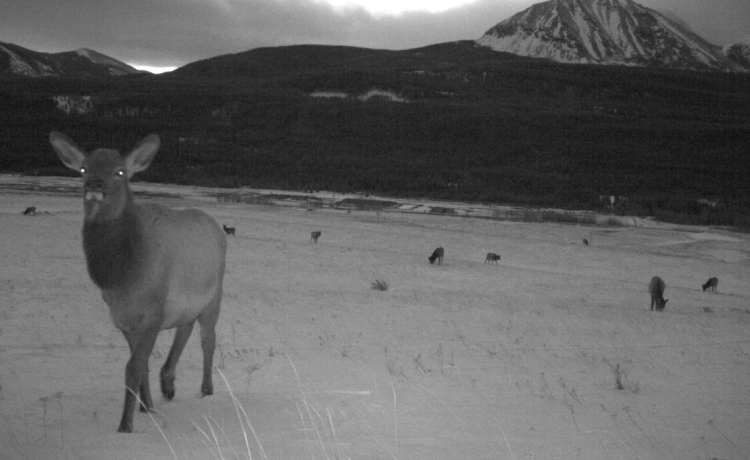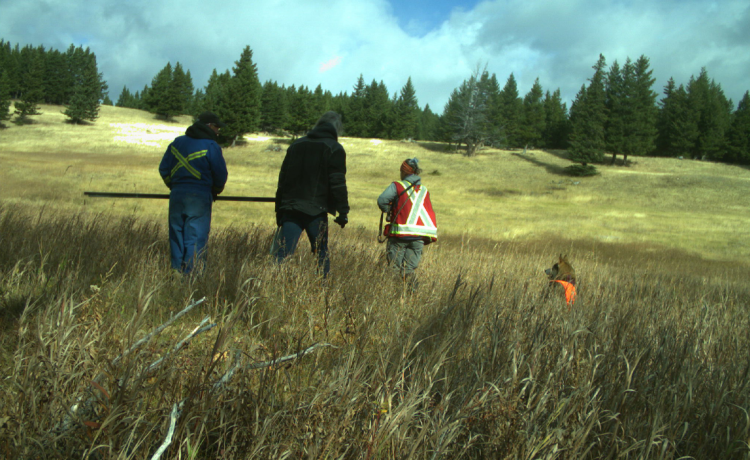Researchers from universities, government and conservation organizations have launched a new initiative to track grizzly bears, elk and deer along Highway 3 in southwest Alberta a key wildlife corridor and a hotspot for animal-vehicle collisions.
The collaborative project, Reconnecting the Rockies Alberta, is using satellite collars and motion-triggered cameras to monitor how wildlife move through the landscape. The data will help inform design and placement of wildlife crossings, including overpasses and underpasses, to make the road safer for both animals and motorists.
"As traffic increases along Highway 3, it's essential we find solutions that support public safety while also protecting the ecological connectivity that allows wildlife to move, migrate and thrive," said Danah Duke, executive director of the Miistakis Institute at Mount Royal University.
"By working together to collect and apply rigorous scientific data, we can ensure this infrastructure supports long-term benefits for both wildlife and communities helping to keep the landscape connected and resilient."
A crucial corridor under pressure
Highway 3 passes through the communities of Coleman, Blairmore, Frank, Hillcrest and Bellevue known collectively as the Crowsnest Pass and is a popular route for both trucks and tourists travelling between Alberta and British Columbia.

The Crowsnest Pass is home to some of the most iconic wildlife in the Rocky Mountains
This region is home to important wildlife such as grizzly bears, bighorn sheep, elk and deer. But the highway cuts through their habitat, creating barriers to movement and increasing the risk of collisions that endanger both animals and drivers.
To address this, Alberta Transportation and Economic Corridors is building special wildlife crossings along the highway. These include overpasses, underpasses, fencing, retrofitted culverts and escape ramps. A similar system on Highway 1 has reduced animal-vehicle collisions by more than 80 per cent and helped hundreds of thousands of animals move safely from one side of the road to the other. Significant progress is expected on the Highway 3 mitigation system over the next five years.
Tracking movement to guide design
To ensure the new crossings are effective, a group of researchers and organizations including the Government of Alberta's Ministry of Environment and Protected Areas, Biodiversity Pathways, Miistakis Institute, Nature Conservancy of Canada, University of British Columbia Okanagan and Yellowstone to Yukon Conservation Initiative are studying wildlife movement across the corridor.

Elk are among the large mammals in the region
So far, the team has installed 80 motion-sensitive cameras and fitted 20 elk, nine mule deer and eight grizzly bears with satellite collars. These collars track how animals move across the landscape, day and night and across seasons. This data builds on earlier research and helps evaluate the impact of the new crossings.
"The Miistakis Institute will be analyzing the remote camera dataset generated from the Reconnecting the Rockies Alberta project to understand which wildlife species are using the landscape near and at planned crossing structures," said Tracy Lee, director of conservation research at Miistakis. "We'll also monitor wildlife use of the new crossing structures once completed.
"This project is a win-win for Albertans, as it will reduce animal-vehicle collisions enhancing motorist safety while also supporting the safe movement of wildlife across Highway 3."
Protecting biodiversity across the Rockies
Wildlife need to cross this vital corridor in the Canadian Rocky Mountains to access food, water and mates, or to make seasonal movements all essential for maintaining healthy populations.

The team has installed 80 motion-sensitive cameras.
"The Crowsnest Pass is home to some of the most iconic wildlife in the Rocky Mountains," said Dr. Clayton Lamb, PhD, wildlife scientist with Biodiversity Pathways and the University of British Columbia. "These animals will teach us a great deal about how to build safer roads and more connected landscapes."
"This project provides an unprecedented opportunity to benefit wildlife in Alberta," added Maria Didkowsky, senior wildlife biologist with the Government of Alberta.
This work is supported by funding from Parks Canada's National Program for Ecological Corridors, Calgary Foundation, Wilburforce Foundation, Woodcock Foundation and the Minister's Special Licence Resident Draw Grants, as well as in-kind contributions of staff expertise and equipment from the Government of Alberta.
Key facts
- Reconnecting the Rockies Alberta is a multi-year research project aimed at understanding wildlife movement along a 56-kilometre stretch of the Highway 3 Transportation Corridor in the Canadian Rocky Mountains from Lundbreck, AB, to the Alberta/British Columbia border.
- Terrestrial large mammals in the region include grizzly bear, black bear, cougar, wolf, bighorn sheep, elk, moose, mule deer and white-tailed deer.
- Animal-vehicle collisions accounted for approximately 60 per cent of the reported collisions on rural highways between 2015 and 2020.
- Animal-vehicle collisions cost Albertans approximately $300,000 a day in direct and indirect costs, including property damage, health care and highway cleanup.













